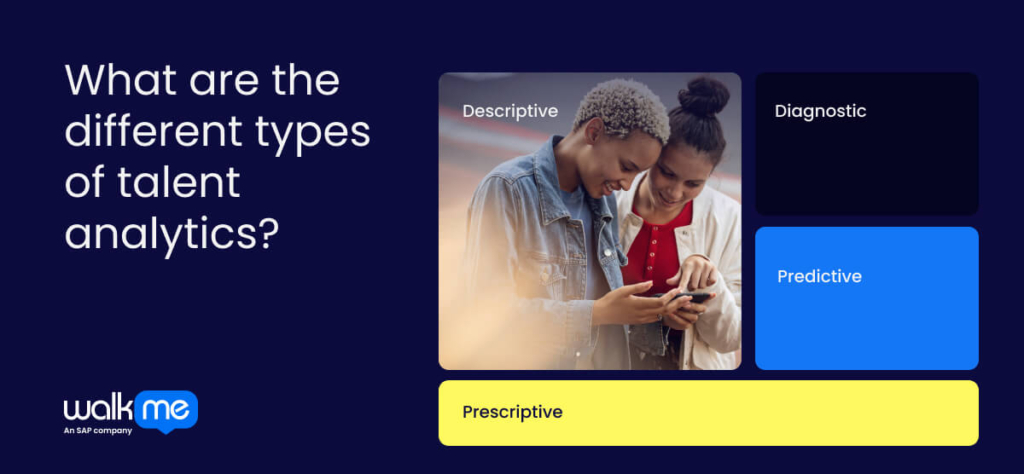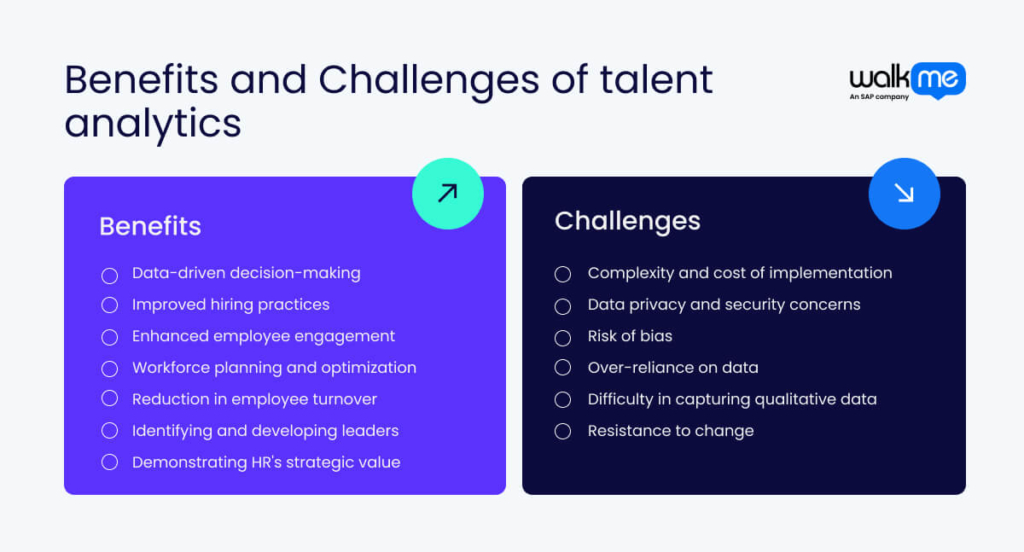In today’s fast-paced business world, companies are always looking for ways to stay ahead.
One area seeing big change management overhauls is human resources. HR teams are moving away from gut feelings and towards hard data to make decisions.
Research by Bain & Company found that businesses that had invested in talent analytics were 40% more productive.
This shift couldn’t come at a better time. With global competition for talent fiercer than ever and the workplace becoming increasingly digital, companies need every edge they can get.
Talent analytics is a new approach that uses technology to gather and analyze data about employees. The goal is to make smarter HR decisions that improve employees’ work experience, engagement, and productivity.
This article will examine talent analytics in more depth, explain how it works, and explain how you can get started with it in your business.
What is talent analytics?
Talent analytics is a data-driven approach HR departments and business leaders use to make informed decisions about their workforce.
It involves collecting, analyzing, and interpreting employee data across various aspects of the employee lifecycle, including recruitment, performance, retention, and development.
By leveraging advanced technologies and statistical methods, talent analytics helps organizations identify trends, predict outcomes, and optimize their human capital strategies.
This approach enables companies to enhance employee productivity, improve retention rates, streamline hiring processes, and align workforce capabilities with business objectives.
Ultimately, talent analytics empowers organizations to make more strategic, evidence-based decisions about their most valuable asset: their people.
Why is talent analytics important?
Talent analytics is vital for modern businesses to optimize their workforce strategies. It provides data-driven insights that improve hiring decisions, enhance employee performance, and reduce turnover.
Identifying skill gaps and predicting future talent needs enables proactive workforce planning. Talent analytics helps align human capital with business goals, increasing productivity and competitive advantage.
It also uncovers factors affecting employee engagement and satisfaction, allowing targeted interventions. This approach minimizes costly hiring mistakes and maximizes return on investment in human resources.
In a knowledge-based economy, leveraging talent analytics is key to attracting, developing, and retaining top performers, directly impacting business success and growth.
What are the different types of talent analytics?

Talent analytics can be generally separated into four distinct types.
These four types often form a progression— you’d begin with the first and incorporate the later types as your business’s talent analytics capabilities improve.
The four types of talent analytics are:
Descriptive
This is the most basic level of talent analytics and involves gathering and interpreting historical data. It helps to describe the current state of your organization by analyzing data on hiring, turnover, employee retention, etc. The goal is to provide insights into what has happened in the past.
Diagnostic
This type of analytics seeks to understand the causes of past outcomes. It involves more detailed data analysis techniques, such as correlations and data mining, to identify patterns and relationships between different factors. Diagnostic analytics helps answer questions like, “Why did a specific outcome happen?”
Predictive
As the name suggests, predictive analytics uses statistical techniques and machine learning models to forecast future outcomes based on historical data. It might involve predicting employee attrition, identifying future high performers, forecasting workforce demand, and more.
Prescriptive
This is the most advanced form of talent analytics. It predicts future outcomes and suggests actions to benefit from these predictions. Prescriptive analytics uses optimization, simulation, and decision-modeling techniques to guide decision-making.
For example, it might suggest the best strategies for improving employee experience or reducing turnover based on predictive analysis.

What are the benefits of talent analytics?
As organizations increasingly recognize the strategic value of their workforce, talent analytics offers a powerful toolkit to transform raw data into actionable insights.
It drives tangible benefits across the employee lifecycle. Let’s take a closer look at the benefits:
Data-driven decision-making
HR decisions become grounded in factual data rather than intuition or subjective opinions. This objective approach promotes more reliable and transparent choices in hiring, promotions, and compensation. Organizations that leverage these insights significantly improve the accuracy and effectiveness of their HR initiatives.
Improved hiring practices
Key traits linked to successful job performance can be identified and targeted during recruitment. This strategy leads to higher quality hires, reduced time-to-fill positions, and decreased early turnover. Aligning candidate selection with proven success factors allows companies to build stronger, more effective teams from the outset.
Enhanced employee engagement
Factors contributing to productivity and satisfaction can be analyzed to create optimal work environments. This insight-driven approach often results in higher employee engagement levels, potentially boosting overall productivity and reducing voluntary turnover. Organizations can tailor their strategies to address specific needs identified through careful data analysis.
Workforce planning and optimization
Future workforce demands can be projected based on business growth, turnover rates, and market trends. This foresight enables proactive hiring strategies and ensures optimal talent allocation. Anticipating future needs helps maintain a well-balanced workforce, avoiding skill gaps or overstaffing issues.
Reduction in employee turnover
Attrition risk factors can be identified, allowing for targeted retention strategies. This proactive approach often reduces turnover-related costs, including recruitment, training, and lost productivity. Addressing potential issues before they lead to resignations helps maintain a stable, experienced workforce.
Identifying and developing leaders
Employees with high leadership potential can be recognized, allowing for focused development efforts. This data-driven approach ensures a strong pipeline of future leaders, contributing to long-term organizational success. Investing in the right individuals helps build a sustainable leadership structure.
Demonstrating HR’s strategic value
Actionable insights that directly contribute to business success can be provided, elevating HR’s role from a cost center to a strategic partner. This shift in perception often leads to increased investment in HR initiatives and greater alignment between HR strategies and overall business objectives.
What are the challenges of talent analytics?
While talent analytics offers significant benefits, its implementation is not without challenges.
Organizations often face hurdles in data collection, integration, and interpretation. Ethical concerns around employee privacy and data security also present complex issues.
The following points explore these challenges in more detail, highlighting the complexities organizations must navigate to leverage talent analytics correctly.
Complexity and cost of implementation
Talent analytics requires substantial investment in technology, infrastructure, and skilled personnel. Organizations must acquire sophisticated data collection tools, analytics software, and storage solutions. Hiring or training data analysts with specialized skills in HR analytics can be costly.
Data privacy and security concerns
Handling sensitive employee data raises significant privacy and security concerns, especially with the onset of AI. Organizations must navigate complex data protection laws and implement robust security measures to safeguard employee information. Balancing the need for comprehensive data analysis with employee privacy rights presents ongoing challenges.
Risk of bias
Despite aiming for objectivity, talent analytics can inadvertently perpetuate existing biases if the underlying data is skewed. Historical hiring or promotion patterns may reflect past prejudices, which predictive models can reinforce. Identifying and mitigating these hidden biases requires constant vigilance and specialized expertise, adding another layer of complexity to the implementation process.
Over-reliance on data
While data-driven decisions are valuable, an excessive focus on metrics can lead to overlooking important qualitative factors. Human judgment and contextual understanding remain crucial in interpreting and applying analytical insights. Striking the right balance between data reliance and human intuition is an ongoing challenge for organizations implementing talent analytics.
Difficulty in capturing qualitative data
Quantifying intangible aspects like employee satisfaction or cultural fit presents significant challenges. Traditional analytics tools often struggle to accurately measure these qualitative factors, potentially leading to incomplete or misleading insights. Developing effective methods to capture and analyze qualitative data requires innovative approaches and continuous refinement.
Resistance to change
Introducing talent analytics often faces resistance from employees and managers accustomed to traditional HR practices. Overcoming this resistance requires effective change management strategies, clear communication of benefits, and ongoing support. Failure to address these cultural challenges can significantly hinder the successful implementation and adoption of talent analytics initiatives.
What are talent analytics metrics?
Talent analytics encompasses various metrics that form the foundation of a comprehensive analytics program.
These metrics represent the specific data points collected and analyzed to gain insights into workforce dynamics.
While the selection of metrics depends on individual organizational needs and goals, several key indicators are commonly used across industries.
The following list highlights some frequently employed metrics in talent analytics, providing a baseline understanding of what organizations typically measure and analyze.
Time to fill
Time to fill measures the total time is taken to fill a job vacancy, from when the job is posted until an offer is accepted. This metric can provide insights into the efficiency of the recruitment process.
Cost per hire
Cost per hire includes all costs associated with filling a job vacancy, such as advertising costs, recruitment agency fees, and the time internal staff spends on hiring activities. This metric can help you understand the financial impact of your hiring practices.
Employee turnover rate
Employee turnover rate measures the number of employees who leave your organization over a given period, usually expressed as a percentage of the total workforce. High turnover can be costly and disruptive, so this is a critical metric for most businesses.
Employee engagement
Employee engagement measures employees’ commitment to their work and their organization.
Engaged employees are more likely to be productive and less likely to leave, making this a key metric for many organizations.
Absence rate
The absence rate measures the frequency and duration of employee absences, excluding planned absences such as vacation. High absence rates indicate low morale or poor health and well-being.
Performance metrics
Performance metrics measure how well employees are meeting their job requirements.
These can include quantitative metrics (such as sales targets) and qualitative metrics (such as feedback from supervisors or peers).
Talent mobility
Talent mobility measures the movement of employees within an organization, such as transfers, promotions, or lateral moves. High talent mobility is a sign of a dynamic, adaptable workforce.
Diversity and inclusion
Diversity and inclusion metrics can include the representation of different groups within the workforce, pay equity, and employee perceptions of fairness and inclusion. These metrics can help you create an equitable and inclusive workplace.
Is talent analytics worth the investment?
The value proposition of talent analytics is compelling, particularly in the long term.
Organizations that effectively leverage these tools gain a significant competitive edge in talent management and overall business performance. However, the landscape is changing rapidly.
As technology advances and becomes more accessible, the barriers to entry for implementing robust talent analytics systems are lowering. This democratization of analytics tools means that the current competitive advantage enjoyed by early adopters may diminish over time.
Eventually, strong talent analytics capabilities will become a standard requirement for businesses to remain competitive in their respective markets.
Given this trajectory, early investment in talent analytics can yield substantial benefits. Organizations can develop expertise, refine their processes, and accumulate valuable historical data by starting sooner.
This head start allows companies to make increasingly sophisticated, data-driven decisions that can transform challenges like employee attrition into opportunities for talent attraction and retention.
FAQs
A talent analyst collects, analyzes, and interprets workforce data to provide insights for HR and business decisions. They use statistical methods and data visualization tools to identify trends, predict outcomes, and recommend recruitment, retention, performance, and employee development strategies. Their work informs evidence-based HR practices and strategic workforce planning.
Talent analytics is designed to solve various workforce challenges and optimize human capital management. It addresses high turnover rates, inefficient hiring processes, skill shortages, low employee engagement, and suboptimal performance. It also helps in strategic workforce planning, identifying future talent needs, and aligning HR initiatives with business objectives to drive organizational success.

